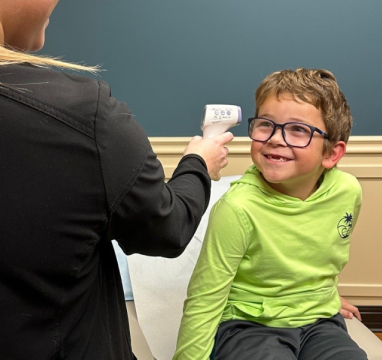Fevers can be alarming, especially in children, but they are often just a symptom, not an illness. It is a symptom of something that is not quite right with the body.”
“A fever alone cannot tell you exactly what is causing it,” says Ryan Lieske, PA. It could signal a bacterial or viral infection, an allergic reaction, or even overheating from excessive activity or sun exposure.
What Is Considered a Fever?
“Normal body temperature ranges from 97.5 to 99.4°F,” explains Lieske. However, a fever is typically defined as a temperature of 100.4°F or higher. He noted that the 98.6 that we were taught was an average.
Lieske said, “High fevers can bring on complications such as seizures or confusion. It is important to remember that it is not how high the temperature is but how fast the temperature goes up that can cause a seizure.
Typically, when a child has a fever they exhibit other symptoms as well such as a flushed face, hot, dry skin, decreased urine output, or darker urine. They may not be interested in eating. They may vomit, have constipation or diarrhea. They may have body aches or headaches. It is also common for children to be fussy and not want to eat.
Diagnosing and Treating a Fever
Digital thermometers are generally recommended for accurate temperature readings (rectal or under the armpit).
He said, “While forehead or tympanic thermometers may be convenient, they can be less accurate in young children.”
Rectal temperatures are most accurate in children under 3 years of age and an older child and adult’s temperature should be taken orally.
Treatment often involves Tylenol (acetaminophen) or Motrin (ibuprofen) and dosing should be according to weight or age, but Lieske advises caution: “Aspirin should never be given to children, and Motrin/Ibuprofen should not be used under 6 months of age.” He added, “Keeping a written log of dosages and times given is a way to avoid errors.”
Dosing of Tylenol/acetaminophen or Motrin/ibuprofen can be done every 6 hours alternating each one every 3 hours but caution should be used as dosages are different for each medication. You should encourage drinking plenty of fluids. You may utilize cold washcloths on the forehead wrists and groin area or possibly a lukewarm bath. It is important not to bundle up someone with a fever as this traps the heat in.
When to Seek Medical Attention
It’s essential to know when a fever requires professional evaluation.
• Any fever in a child younger than 3 months of age should be evaluated.
• Seek medical attention if a fever is accompanied by seizure activity, confusion, stiff neck, irregular breathing, or a purple-spotted rash.
• Persistent fever lasting 3-5 days, or other symptoms like painful urination, sore throat, or ear pain, should also prompt a visit to your healthcare provider.
By staying informed and vigilant, parents can confidently manage their child’s fever while knowing when to reach out for help.



